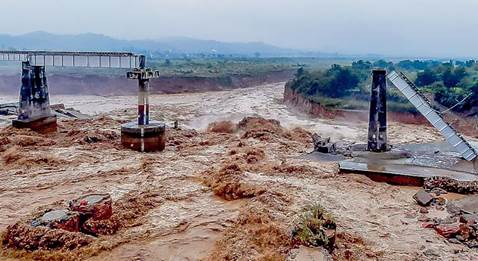Description

Disclaimer: Copyright infringement not intended.
Context
- Himachal Pradesh Chief Minister expressed concern over the loss of life and property due to torrential rains and flash floods in various parts of Himachal Pradesh.
Flash Floods
- Excessive or continuous rainfall over a period of days, or during particular seasons can lead to stagnation of water and cause flooding. Flash floods refer to such a situation, but occurring in a much shorter span of time.
US Definition
- The US’s meteorological agency, the National Weather Service, says flash floods are caused when rainfall creates flooding in less than 6 hours. It adds that flash floods can also be caused by factors apart from rainfall, like when water goes beyond the levels of a dam.
In Indian context
- In India, flash floods are often associated with cloudbursts – sudden, intense rainfall in a short period of time.
- Himalayan states further face the challenge of overflowing glacial lakes, formed due to the melting of glaciers, and their numbers have been increasing in the last few years.
How common are flash floods and floods?
Data from Assam State Disaster Management Authority
- According to government data from a project by the Assam State Disaster Management Authority, India is the worst flood-affected country in the world after Bangladesh and accounts for one-fifth of the global death count due to floods.
- Flash floods have been commonly witnessed in cities like Chennai and Mumbai. Depression and cyclonic storms in the coastal areas of Orissa, West Bengal, Andhra Pradesh, and others also cause flash floods.
NDMA Data
- National Disaster Management Authority states that one of the reasons for flood situations occurring so frequently, is that nearly 75 per cent of the total Indian rainfall is concentrated over a short monsoon season of four months (June to September).
- As a result, the rivers witness a heavy discharge during these months.
National Flood Commission Data
- About 40 million hectares of land in the country are liable to floods according to the National Flood Commission, and an average of 18.6 million hectares of land are affected annually.
Concern
- Flash floods may in the future, begin to take place after wildfires that have been taking place more frequently. This is because wildfires destroy forests and other vegetation, which in turn weakens the soil and makes it less permeable for water to seep through.

Final thought
- One way of dealing with the current situation is a comprehensive strategy of monitoring on the ground in hilly areas, planning development works in a way that is sensitive to the region’s ecology, and mitigation to reduce the extent of damages.
Must Read: https://www.iasgyan.in/daily-current-affairs/flash-floods
https://indianexpress.com/article/india/19-states-cross-pre-covid-gsdp-levels-in-fy22-kerala-up-lag-8103825/
















